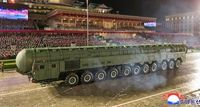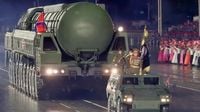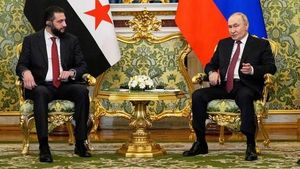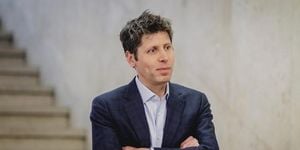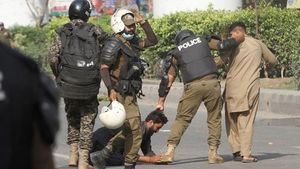On the night of October 10, 2025, Pyongyang’s Kim Il Sung Square was ablaze with lights, marching feet, and the thunderous spectacle of military might. North Korea marked the 80th anniversary of its ruling Workers’ Party with a grand parade that was as much a show of force as it was a celebration of the regime’s longevity. According to the Rodong Sinmun and multiple international outlets, the event mobilized at least 16,000 troops and drew roughly 40,000 participants, including civilians, in a carefully orchestrated demonstration of unity and power.
Despite a forecast of steady rain—about one millimeter per hour, as reported by South Korea’s Joint Chiefs of Staff—the parade pressed on, its drama perhaps heightened by the wet conditions. For days leading up to the event, North Korean forces conducted final night rehearsals, a scene reminiscent of recent Chinese military preparations, as noted by analysts at NK Pro and confirmed by South Korean intelligence officials. The timing and scale were no accident: the regime had been preparing for months, aiming to send a clear message both at home and abroad.
The centerpiece of the parade, and the focus of much international scrutiny, was North Korea’s unveiling of the Hwasong-20 intercontinental ballistic missile (ICBM). Described by Kim Jong-un’s regime as the “most powerful nuclear strategic weapon system,” the Hwasong-20 appeared atop an imposing 11-axle mobile launcher. State media and defense analysts alike highlighted its potential to carry multiple independently targetable reentry vehicles (MIRVs), a capability that—if realized—could overwhelm even advanced U.S. missile defense systems. Yet for all the fanfare, military experts cautioned that the missile remains in development. As of October 10, there had been no verified test launches of its MIRV capability, and its true operational status remains uncertain.
What sets the Hwasong-20 apart, according to coverage from the National Security Journal and JoongAng Daily, is its likely use of solid-fuel technology and carbon composite materials. These advances promise greater structural strength and reduced mass, potentially allowing for heavier warheads or longer range. In theory, the missile could strike the continental United States—an assertion that, if proven, would represent a significant leap in North Korea’s nuclear deterrent. But for now, these claims remain largely untested outside the parade grounds.
Kim Jong-un, standing before a reviewing stand packed with high-level foreign dignitaries, delivered a speech heavy on resolve but light on direct threats. He spoke of the “heavy responsibility of containing the worst threat of aggression from the outset of its founding,” yet avoided naming the United States or South Korea outright. Instead, his words and the weapons on display served as implicit warnings. “Our military should continue to grow into an invincible entity that destroys all threats,” Kim declared, according to the Rodong Sinmun.
The audience for this display was international as well as domestic. Chinese Premier Li Qiang, Russian Deputy Chairman of the Security Council Dmitry Medvedev, and Vietnamese Communist Party secretary To Lam all watched from the principal viewing section. Medvedev’s presence, in particular, underscored the deepening ties between Pyongyang and Moscow. “Friends are together, enemies are nervous,” Medvedev posted on the Russian state-backed messenger platform MAX, signaling a more assertive anti-Western alignment. Analysts from the National Security Journal noted that some of North Korea’s recent weapons advancements are at least partially credited to military technology transferred from Russia—missile design, rocket motors, and more—in exchange for North Korean soldiers fighting alongside Russian forces in Ukraine and shipments of munitions.
The parade was more than just a platform for the Hwasong-20. North Korea also showed off a hypersonic variant of the Hwasong-11Ma, a glide-bodied missile capable of speeds above Mach 5 and designed to evade missile defense systems. Its maneuverable glide vehicle, shaped like a stingray, is intended to extend the range of short-range missiles and target not only all of South Korea but also U.S. military bases in Japan. The design drew immediate comparisons to Russia’s Avangard and China’s DF-17, raising questions about possible technology transfers or covert cooperation among these nations.
Other advanced systems made their debut as well. The parade featured strategic cruise missiles from the Hwasal series, believed capable of striking U.S. military assets on Guam and aircraft carriers near the Korean Peninsula. Observers also noted the appearance of the KN-24 and KN-25 short-range ballistic missile systems, which North Korean state media described as “the world’s only cutting-edge weapons.” These systems are reportedly part of a missile package sent to Russia and are undergoing iterative upgrades based on battlefield experience.
Conventional weapons modernization was another major theme. North Korea rolled out the Chunma-20 main battle tank, a 155-millimeter self-propelled howitzer, and a new 22-tube wheeled multiple launch rocket system—developments intended to narrow the gap with South Korea’s K2 tanks and K9 howitzers. A loitering munition drone system, modeled after Israel’s Harop and mounted on a six-cell mobile launcher, also made its first appearance. This reflects Kim’s August 2024 directive to expand the production of unmanned aerial systems, with experts predicting that North Korea may employ drones, rockets, and missiles in simultaneous salvos to overwhelm South Korean air defenses.
“Revealing a comprehensive mix of strategic, tactical and asymmetrical weapons reflects Kim’s intent to project military confidence and strengthen diplomatic leverage despite international isolation,” Lim Eul-chul, a professor at Kyungnam University, told the JoongAng Daily. The parade’s timing was significant as well: 2025 marks the conclusion of North Korea’s five-year weapons development plan, a milestone the regime is eager to showcase as evidence of its technological prowess and self-reliance.
One notable absence was Kim Jong-un’s daughter, Kim Ju-ae, who has been a fixture at previous high-profile events but has not appeared in public since accompanying her father to China in September. Her absence did not go unnoticed, fueling speculation about her role and status within the regime.
For all its pageantry and symbolism, the parade was also a stark reminder of the security challenges facing the Korean Peninsula and the wider region. The appearance of advanced missiles, drones, and rocket systems underscored North Korea’s determination to modernize its arsenal and assert itself on the global stage. As the fireworks faded and the soldiers marched off into the rainy Pyongyang night, one thing was clear: North Korea’s message was intended for far more than just its own people.
